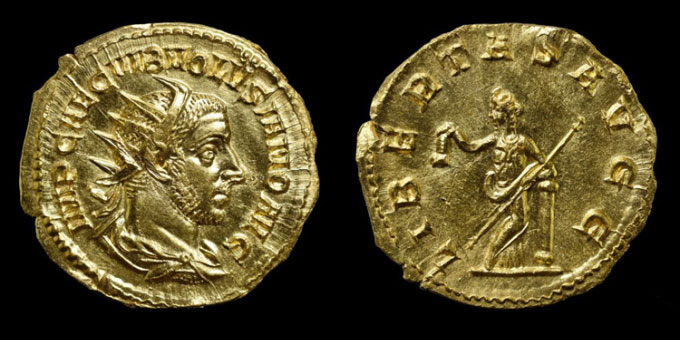Gold coin engraved with the portrait of the murdered Roman emperor
The 1,700-year-old 5.6-gram gold coin features the emperor Volusianus and Libertas on both sides.
A museologist at the Rippl-Rónai museum, in the city of Kaposvár, and volunteers dug a rare Roman gold coin earlier this year. The coin depicts the emperor Volusianus, who with his father ruled the Roman Empire for about two years.

Roman coin with one side depicting the emperor Volusianus, the other side is the god of liberty Libertas. (Photo: Krisztián Balla)
At the age of 22, Volusianus was murdered by his own soldiers. Because Volusian's reign was so short, coins with his face inscribed on it were very few. Besides, it is also very rare to find Roman gold coins of this denomination in Hungary, according to Máté Varga, an archaeologist at the University of Szeged who led the excavation team.
Experts have not yet identified the coin's owner. This is the only gold coin unearthed in this area so it is likely that someone has lost it. "It must be a great loss to the former owner to lose such a valuable coin," Varga said.
The team found the coin while excavating a Roman settlement in Somogy, southwestern Hungary, but Varga did not disclose the exact location. "The exact location is kept secret at this time as the archaeological site is still under investigation. Illegal metal detectors are a big problem in Hungary so we can't reveal the location yet." he explained.
A gold coin weighing 5.6 grams was minted under the emperor Volusianus, from 251 to 253. One side of the coin is a portrait of the emperor with a thick beard, crowned head. The other side depicts Libertas, the god of liberty.
This coin is also not a "change of money". "The face value of the coin is not the usual aureus but the rare binio with twice the value of aureus," said Marjanko Pilekić, a researcher at the Schloss Friedenstein Gotha Foundation Coins Department (Germany).
Pilekić commented, the coin discovery was "awesome and exciting". "Judging by the photo, the condition of the coin is also very good," he said. The coin is now part of the currency collection in the Rippl-Rónai museum.
Archaeological work at the site where the coin was discovered is still ongoing. Based on unearthed artifacts, including gold coins, it seems likely that the Roman settlement existed in the 3rd and 4th centuries, when it was part of the Roman province of Pannonia Superior. Other artifacts include several Roman silver and bronze coins, a bronze key, an engraved silver ring and a glass pin.
- Rare gold coin engraved with Roman emperor
- Gold coins 2,000 years of casting the Roman emperor was deified
- The gold coin jar buried more than 1,500 years under the Italian theater
- The 'socks' are 1,800 years old gold rings
- Found extremely rare ancient Roman coins worth more than half a billion
- Mysterious beautiful face engraved on a 2,000-year-old sapphire ring of the Roman emperor
- America: Change of life because
- Revealing the gay lover of the Roman emperor
- The Roman emperor and the hobbies' room
- Rich by accidentally picking up a coin of 7.4 billion VND in a pile of toys
- Discovered where the first Roman Emperor was born
- The image depicts the portrait of Jesus on an ancient coin
 Discovered an ancient centipede fossil 99 million years old
Discovered an ancient centipede fossil 99 million years old Discovered bat-like dinosaurs in China
Discovered bat-like dinosaurs in China Discovered a 200-year-old bronze cannon of the coast
Discovered a 200-year-old bronze cannon of the coast Discover 305 million-year-old spider fossils
Discover 305 million-year-old spider fossils The Mystery of Money That Shouldn't Exist
The Mystery of Money That Shouldn't Exist  Rare ancient coin sold for record price of nearly 2.1 million USD
Rare ancient coin sold for record price of nearly 2.1 million USD  China issues a set of 3 gold and silver coins to celebrate the first Mars exploration mission
China issues a set of 3 gold and silver coins to celebrate the first Mars exploration mission  Special gold coins appeared for sale up to 50 billion
Special gold coins appeared for sale up to 50 billion  Found extremely rare ancient Roman coins worth more than half a billion
Found extremely rare ancient Roman coins worth more than half a billion  Finding coins makes 'changes' throughout Australian history
Finding coins makes 'changes' throughout Australian history 